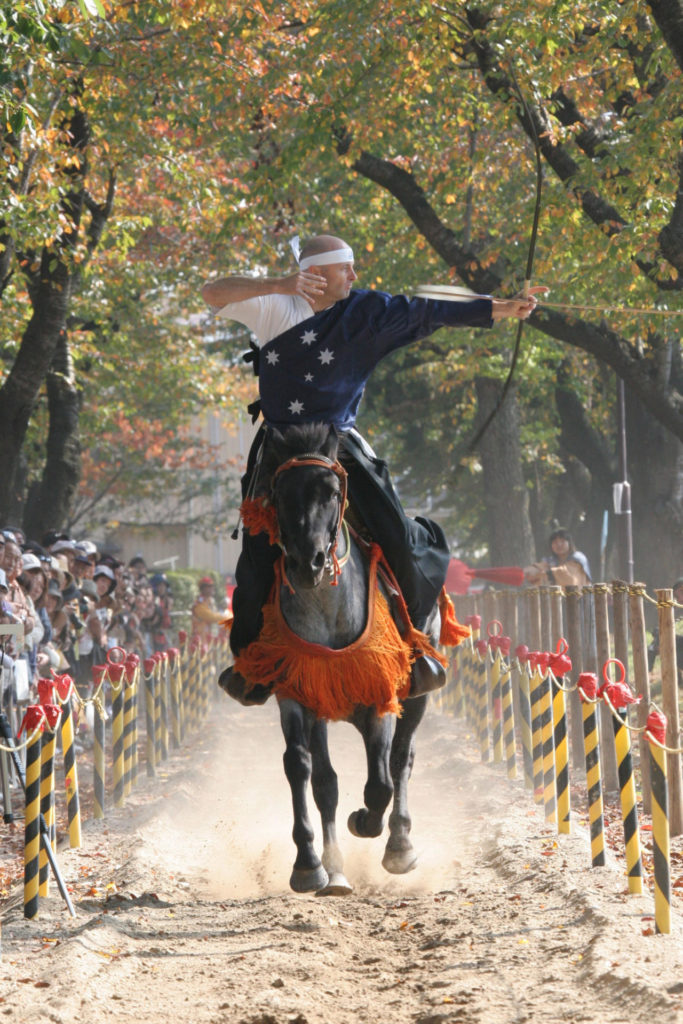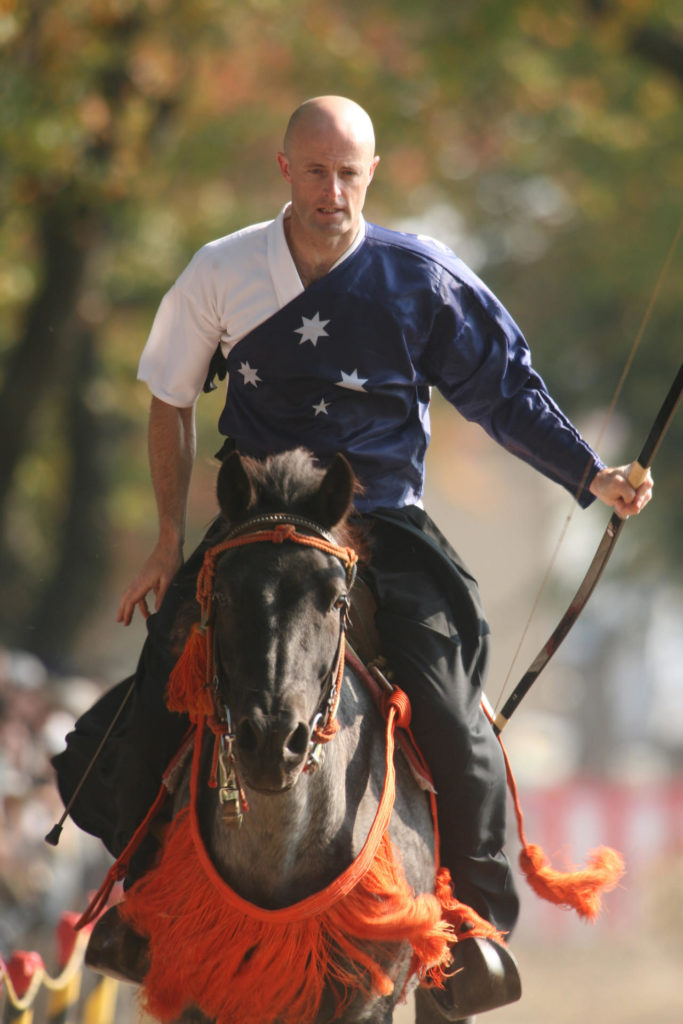Like many Hokkaido residents, Gregory Stewart is an avid sportsman who enjoys snowboarding, telemark and cross country skiing, hiking, paragliding and even ice climbing. Gregory has been living in Shihoro, Hokkaido, since 2005 working as an ALT Teacher, and I’ve known him for a few years, but just recently I found out he’s been practicing yabusume, a traditional Japanese martial art that involves riding horses and shooting arrows.

More surprisingly, after taking up the sport for just a year, he became the Japan Yabusume Champion. Amazed, I met up with him to find out how it all happened.
First off, what is yabusume and how did you get into it?
I’ve been interested in martial arts since I was a kid. I did judo, some kung fu and a little aikido as a young man. I already had a vague interest in yabusume (traditional Japanese equestrian archery), because I’d been doing kyudo (Japanese archery) for a couple of years here in Hokkaido.
Someone told me there was an annual yabusume tournament in nearby Memuro, and I wanted to check it out, so I asked my Japanese teacher about it. She happened to know Hiroyuki Kawahara, the guy in charge of the tournament who also owns a horse ranch in the Hidaka area. My teacher asked Kawahara if I could come watch the tournament, but he asked if I’d be interested in participating in it.
At the time I was recuperating from an ice-climbing fall that messed up my shoulder and didn’t think I could do it, particularly since the tournament was only four weeks away. I told my friend Adam Cook about it, and he was keen to join, so I went along to the horse ranch to see what it was all about.
The yabusume bows were a lot lighter than what I used in kyudo, and you didn’t have to stretch your shoulders as forcefully so, swept up in all the excitement, I decided to give it a try.
“(Kawahara) lined us up on the yabusume track and told us when we dropped the reins, the horse would bolt. He advised us not to fall off.”
I was not a horseman in any way, so I was pretty nervous about the riding aspect of yabusume. I figured there would be a gradual learning process, maybe leading up to galloping by the fourth week. However, Kawahara was having none of it. He lined us up on the track (馬場) and told us when we dropped the reins, the horse would bolt. He advised us not to fall off.
On our second or third gallop, he handed us bows and told us to try a shot at the target. My first shot missed completely, disappearing into the forest…that’s where it all started.
Did it help being thrown in the deep end like that?
I think the only way to do anything is to go at it as hard as you can, so it was OK for me.
How did that first tournament go?
Not too well, actually. I didn’t fall off my horse, an accomplishment in itself, and I got all my arrows fired off, which is one of the hardest parts of yabusume. You only have a few moments to pull an arrow out of your obi (belt), notch it on the string and draw the bow to shoot. This is made even more difficult while trying to maintain your balance, standing up in the stirrups as your horse goes full speed down the track.
It’s common to still be trying to get your arrow on the string as you go flashing past a target and only firing one or two arrows instead of all three. Adam and I spent as much time practicing notching arrows as we did riding, and it really paid off.
The other big challenge in yabusume is absorbing the horse’s up-and-down motion with your legs, thus keeping your upper body relatively still, so you can make an accurate shot. It’s pretty tough to make a good shot if your upper body is bouncing up and down.
Adam was a more skillful and experienced rider than me, and he did really well in that first competition. He was tied for second place at the end and had a “shoot-out” ride to decide second and third place. He did brilliantly, but the other guy did just a little better.
I think good riding technique is the most important skill in yabusume since the shooting is at a pretty short distance. The winner that day was a woman who is a fantastic rider. There’s also a pair of junior high school girls competing in the tournaments; they’re both phenomenal riders and, once they get their shooting down, the rest of us might as well pack up and retire.
Where did you place in that first tournament?
I don’t remember, but it was well down in the rankings; the same with my second competition in Hakodate. I was on a borrowed horse from another ranch which I had only ridden once before the competition, so I didn’t have a chance to get used to his running style. My horse also arrived late, so I didn’t get a proper warm-up. It really messed up my shooting. The Hakodate tournament was cool, though. They hold it on a little island sticking out into the harbor.
Fast forward and a year later you are the Japan Champion…!
The All-Japan Championship is held at a different venue each year, conducted concurrently with a local tournament. This time the event was at Eniwa, and Kawahara brought horses from our ranch. He hadn’t brought the horse I’d been training on the most, though. That horse had thrown Kawahara badly the weekend before and was generally misbehaving, so he benched him. Good thing, too. He’d also thrown me once, and I wasn’t too fond of him.
The All-Japan Championships and the local Eniwa Yabusume Tournament were held that day. All the horses seemed to be running slowly and everyone’s scores were low. At the end of the day, somehow I was in a tie with an iaido (a Japanese martial art using a sword) sensei from Tokyo. But rather than having a shootout, the officials declared me the winner, because my last ride had been a second or so faster than the other guy. No one was more surprised than me.
One of the officials said all the other competitors were going to gang up and kill me after the awards ceremony…I’m pretty sure he was joking. Actually, one of the best things about the tournaments is seeing the same group of faces. They’re all very cool, interesting people, and I look forward to seeing them again this year.
How does it feel to be the first international champion?
Well, I should point out that, although I won the All-Japan Tournament, I didn’t win the Eniwa event that day. I’m not sure how the scoring was calculated, but a guy from Kita-Hiroshima won it.
Honestly, I don’t know how legitimate is the “All-Japan” title, since I doubt anyone farther west than Tokyo even knows there is a championship.
There are yabusume demonstrations and ceremonies in western Japan, but I’m not sure there are any competitions. In fact, if someone from the Takeda-ryu Yabusume School in Kamakura came to compete, I doubt the rest of us would have a chance. But, you never know; it would be interesting to find out.
Most Japanese think of yabusume closely associated with ceremonies and festivals at shrines and temples, rather than a sport. Personally, I hope the competition aspect of yabusume grows until people are competing from all over the country – maybe even all over the world.
They do a slightly different form of yabusume in Korea as well as in Mongolia, and I would imagine Native Americans have some kind of horseback archery competition. Various armies from the Middle East employed horseback archery in the past. Wouldn’t it be cool to see a tournament where all these different styles of bows and riding were being used?
“I spend the whole season badly bruised and unable to sit or walk comfortably. I’m pretty sure I have permanent tail-bone damage.”
What about the outfits you wear? I hear yours is unique.
One of my favorite aspects of yabusume is the gorgeous costumes the competitors wear. They really go all-out. The two junior high-school girls have several beautiful kimono they wear, and the woman who won the Memuro competition, Tomoko Ono, arrives at each competition in a different kimono; they all look wonderful. But the costumes of the women in Aomori are really colorful. They look Chinese-Mongol to me, but I’m told they’re actually Japanese. Some of those ladies even color-coordinate their bows and their costumes…they’re amazing.
The best men’s costumes I’ve seen are worn by the iaido guys from Tokyo; deerskin leggings, bearskin covers for their katana (swords) and wonderfully dignified kimono. I wish I could afford a fantastic costume like that, but I’m just a poor, underpaid teacher, so I make do with my kyudo uniform.
However, my mom used an Australian flag to make my imote, a half-jacket we wear on our bow-arm. It has a Southern Cross and Federation Star on the front and the Union Jack on the back. It’s not very traditional, so perhaps it’s a bit out of place in yabusume, but I’m proud to wear it. I also have a hachimaki with the Australian flag on it. My kyudo sensei made that for me.
And the horses…
They receive nearly as much attention. Most of the riders use a traditional Japanese wooden saddle—an evil invention. The rider sits between two high wooden ridges at the front and back of the saddle (sort of like the saddle horns on a western saddle, only less user-friendly).
My legs are too long, so the ridge at the front cuts into the inside of my legs and, if I lose my balance momentarily when I’m standing in the stirrups, I fall back and land on the rear ridge. I spend the whole season badly bruised and unable to sit or walk comfortably. I’m pretty sure I have permanent tail-bone damage. Some of the other competitors use western saddles which are super-comfy. I think they’re cheating but, of course, I only say that because I’m envious.

Would you like to introduce the sport back in Australia someday?
Absolutely. I fully intend to. I’m told there are a couple of people in Sydney who have practiced yabusume. I’m hoping to hook up with them when I get back and start up a school or something. One day I’d like to bring a team of competitors back to Japan to compete. Not sure when that will be, though. I’m not ready to leave Japan just yet.
What was the reaction from the yabusume community in Hokkaido after you won?
There wasn’t much of a reaction at all. I haven’t seen most of the people since the competition and, with my meager Japanese skills, I wouldn’t know if they were talking too much about it anyway. But, from the start, the yabusume community has been very welcoming and supportive.
I think they appreciate there are some non-Japanese interested in this aspect of Japanese traditional warrior culture and willing to train and try their very best. It’s a sign of respect, and I think they are pleased by that. I did get a wonderful reaction from people in my town when they found out about it.
Also, I don’t think yabusume gets a whole lot of attention from the general public. Most people to whom I’ve spoken have never seen yabusume and virtually no one has tried it. I find this amazing. Personally, I’d try everything once if I had the chance.




